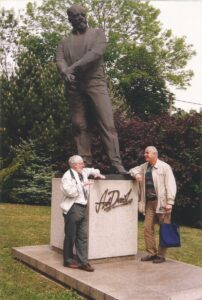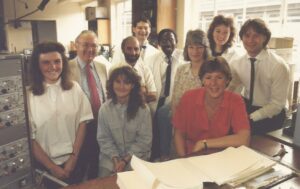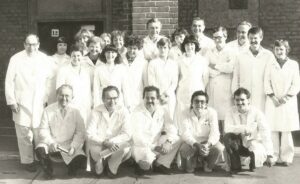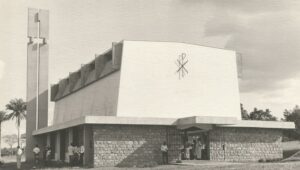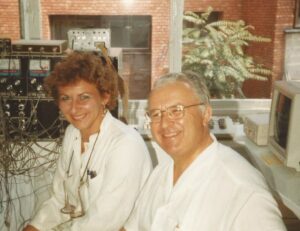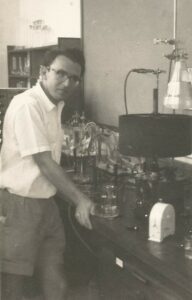
Physiology News Magazine
Adventures in physiology – celebrating 60 years of membership
Membership
Adventures in physiology – celebrating 60 years of membership
Membership

Professor Jim Parratt
Alumnus of University College London, UK
Adventures in Physiology is the title of a book by Sir Henry Dale published 70 years ago in 1953 and later reprinted (Dale, 1965). It is a collection of his research papers, some as far back as 1902, including many first published in The Journal of Physiology. As a first-year research student, I was fortunate to be introduced to the great man at a meeting of The Physiological Society. My hand was then not washed for several days!
This year I celebrate two special events: my 90th birthday and, perhaps even more significant, 60 years as a member of The Physiological Society. These milestones and the 70th anniversary of Dale’s book made me think about my own paths in science.
My journey with The Society began in the mid-50s when I first attended their meetings and which coincided with my first publications in The Journal about my research on mast cell mediators. One of my papers on the anaphylactoid reaction (Parratt and West, 1957) became a stimulus for much later studies, in collaboration with a group in Strasbourg led by Professor Jean-Claude Stoclet and supported by a grant from the Commission of European Communities, on the role of nitric oxide in shock induced by bacterial endotoxin and sepsis. We first presented our results at The Society meeting in Oxford in 1989 (Fleming et al., 1990).
The 1950s and 60s were dominated by the discovery of drugs that prevent the effects of endogenous substances, such as histamine and the catecholamines, on receptors. Intrigued, I wrote to the Rhône-Poulenc organisation in France requesting some of their compounds that antagonised the effects of histamine. I received a positive response from the lead pharmacologist, Dr Parot. These were the days when histamine was assayed on the guinea-pig ileum, the contractions being recorded by a lever on a smoked drum, a piece of physiological equipment now found in museums. When I first met another renowned physiologist, Wilhelm Feldberg (a one-time collaborator of Dale) he too was using this technique, gently tapping the work bench to return the lever to the baseline. Only after this was successful were we introduced!
I was elected a member of The Physiological Society in 1963, by which time I was teaching physiology to medical students in Nigeria. University College Ibadan was Nigeria’s first university, founded in 1948 in collaboration with the University of London. I remained there for almost 10 years. These adventurous years included independence (1960), the military coups (my family reasonably safe behind military guards at the entrance to the university complex) and the “evacuation” of students and staff who had come from what was then Eastern Nigeria. As a family we left Ibadan a few months before the start of the civil war.
With only about 30 or 40 students to teach there was ample time for research, well-funded by the West Africa Medical Research Council. It was in Ibadan that I began a life-long interest in the regulation of coronary blood flow. I think I might be the only one who has studied this in a hyena and a baboon, “gifted” to us by the university zoo because of bad behaviour – theirs not ours! It is difficult to publish with results from just one animal.
It was difficult at that time to return to a university department in the UK from as far away as Nigeria but an airmail letter out of the blue brought me to Glasgow, where a new department had been formed at the University of Strathclyde, the origins of which go back over two centuries to Anderson’s University and Medical School; the original Chair of Physiology was created in 1799.
My first opportunity to work in a European laboratory came as a post-doctoral fellow with Wilhelm Lochner at the Physiologisches Institut in Düsseldorf, one of two German laboratories working at that time on coronary blood flow control. At that time, the most significant publications in this area were in German, then considered perhaps the most important language for scientific publications. For example, British pharmacologist Sir John Henry Gaddum’s classic monograph Vasodilator substances of the tissues was first published in German in 1936. Only 50 years later did the Cambridge University Press publish an English edition (Gaddum, 1986). It was hearing a lecture by Gaddum that inspired me to attempt a life in basic medical research.
A longer-lasting adventure in physiology began when I was invited to speak at a meeting of the Polish Physiological Society in the early 1970s. This stimulated frequent visits during the communist period to Poland, Czechoslovakia, Hungary and East Germany (DDR). Working, and then living, in Eastern Europe through the 70s to the 90s became the most stimulating and exciting period of my life in medical science. This was at a time when only a few British scientists collaborated with scientists working in the “Eastern bloc”. These visits were not without risk, both to them and to myself (Parratt, 2021).
Many younger colleagues from Eastern Europe came to work with me in Glasgow at the University of Strathclyde. Then in 1990, the EU funded the European Network on the Protection of the Heart, which I chaired. This linked departments in Germany, France, Holland, Spain and Scotland with those in the former DDR, the Czech Republic, Slovakia, Poland and Hungary. The final meeting in London in 1998 corresponded with my official retirement.
Following my retirement, I was awarded an Emeritus Fellowship from the Leverhulme Trust and later, a Szent-Győrgyii Fellowship from the Hungarian State Government. This enabled me to continue to live and work in Hungary. It was from there that I published my final paper (2005), which was concerned with the protective effects of exercise on the heart, almost 50 years after my first publication in The Journal of Physiology.
I believe the current tendency is for postgraduate studies to be undertaken at various eminent universities in the USA, where the language is quite like our own. This is often followed on return to the UK by rapid promotion into the “profusion of Professors”!
I hope these experiences will be an inspiration to early career researchers. I would like to make a plea that younger physiologists continue to examine the possibilities of “looking east” rather than west. This despite the disastrous effects of Brexit on such collaborations. You will be rewarded not only with good science, and great friendships, but with all the other benefits that European culture brings.
References
Dale, HH (1965). Adventures in physiology. The Welcome Trust, London, UK
Fleming I et al. (1990). Impaired vascular reactivity following endotoxin treatment can be endothelium independent, yet involves the L-arginine pathway. The Journal of Physiology 423, 18.
Gaddum JH (1986). Vasodilator substances of the tissues. Cambridge University Press, UK.
Parratt JR (2021). A scent of water; adventures in faith and science. Handsel Press, Edinburgh, UK.
Parratt JR, West GB (1957). 5-Hydroxytryptamine and the anaphylactoid reaction in the rat. The Journal of Physiology 139, 27-41.

